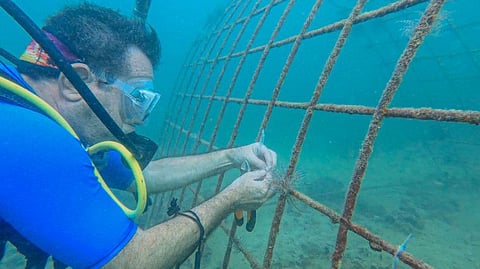EPAA implementing coral reef cultivation in Sharjah
The coral reef farming project in Hamriyah to significantly contribute to rehabilitation

Sharjah: The Environment and Protected Areas Authority in Sharjah (EPAA) has started implementing a coral reef cultivation project in the Al Hamriyah region of Sharjah. The project aims to achieve sustainable development of marine life, increase biological cover and biodiversity as well as rehabilitate marine life in the area.
The coral reef farming project in the Al Hamriyah region will significantly contribute to the rehabilitation and restoration of coral reef areas and will aid in the flourishing of marine life and fisheries, as coral reef farming has been used successfully to restore balance to the marine environment and achieve long-term sustainability.
Cultivating the most common types of corals in the Gulf
Hana Saif Al Suwaidi, chairperson of the EPAA, said: “The coral reef cultivation project in the Al Hamriyah region is divided into two phases. The first involves the installation of bases (metal wires) in shallow areas ranging from six or seven meters deep, and then monitoring them during the growth period, which is usually in the summer after the end of the breeding season, because it achieves the highest rates of growth and survival compared to the winter season.”
The second stage involves transferring the coral colonies from their places of growth and fixing them in the places to be developed and established as well as following up on survival and growth rates. “The project works to maximise the use of biological material, such as coral reefs, to produce large quantities of colonies instead of obtaining them from where they are,” she added.
Al Suwaidi said that four types of hard coral reefs common in the Arabian Gulf have been cultured, which are ‘Acropora’, ‘Porites’, ‘Turbinaria’ and ‘Platygera’.
Massive production of coral colonies
According to Al Suwaidi, the techniques that have been used in this project are very simple, so that they can be easily replicated in the future, and during this year other techniques will be used that help to produce a very large number of colonies using one small colony.
Coral reefs are important elements of marine life because they are a refuge and a haven for marine organisms and fish. They are considered a national wealth for future generations as they help ensure sustainable food security. The goal of coral reef farming is to determine the types of reefs that can be cultured, and the appropriate environmental conditions in terms of depth, lighting and currents that can give the best results.
In addition to benefiting from the use of cultivated reefs in rehabilitating coastal areas destroyed as a result of urban construction, cultivating them in different places creates a suitable environment for coral growth and settlement of fish, attracts divers and amateurs, and raises awareness among divers and the public.
Through the process of coral reef cultivation, some natural corals are collected to be planted in cages, in order to grow and propagate later.
Corals are living organisms
Coral reefs are structures consisting of living organisms found in shallow waters in general, and they are an elevated part of the sea floor in a relatively shallow area, consisting of rocks resulting from the accumulation of calcareous exoskeletons of coral animals, red limestone algae and molluscs. Living coral animals build coral reefs layer after layer, over the structures of the coral generations that preceded them and are distinguished by their ecological systems.
Coral reef farming is not the first project that the EPAA is working on in this regard, as it has already implemented a similar initiative on the Sir Bu Nair Island Reserve, where the coral reef is considered one of the most diverse in the Arabian Gulf. Coral reefs in the island extend to as far as 20 metres deep in the sea, but in recent decades have suffered from severe deterioration due to natural and human factors as a result of many wrong practices, and therefore it was necessary to immediately move to rehabilitate the destroyed coastal areas, which enabled the agency to spot about 40 species from the original coral reefs.
EPAA in Sharjah seeks to protect the environment, natural reserves, wildlife and their biodiversity through scientific studies and research. The authority publishes educational awareness material, implements policies for environmental awareness and programmes, and launches specialised campaigns in the field of environmental awareness and education.
Sign up for the Daily Briefing
Get the latest news and updates straight to your inbox









